
FRIDAY EVENING, AUGUST 21, 2015.
TREASURE TROVE OF EARLY P. G. WODEHOUSE WRITINGS RECOVERED
Experts attribute and publish hundreds of paragraphs and poems from London’s Globe newspaper, 1901–1908


The front covers feature a photograph of 21-year-old P. G. Wodehouse that was originally published in the September 1903 issue of The Captain.
The photo has been restored and colorized by Laiz Kuczynski.
The P. G. Wodehouse Globe Reclamation Project announces the publication of P. G. Wodehouse in the Globe Newspaper, 1901–1908, Volumes 1 and 2. The books are the first results of a three-year effort by an international group of Wodehouse scholars to obtain and study Wodehouse’s daily “By the Way” columns, found to have contained thousands of short paragraphs and verses attributable to him. Unseen for over 100 years and scanned from microfilm in London and Los Angeles, the columns not only shed new light on an important, formative period of his career, but also many display “the brilliant craftsmanship and wit for which P. G. Wodehouse has always been known,” according to GRP founding member John Dawson.
In 2011, Sir Edward Cazalet, Wodehouse’s grandson, permitted the group to obtain a copy of Wodehouse’s 114-year-old journal, “Money Received for Literary Work,” which lists the days and weeks he worked at the Globe. “Because the column was written in the morning and published in the evening,” Dawson said, “Wodehouse’s journal allowed us to identify the exact 1,378 issues we were looking for. From there, our volunteers in three countries built the archive and began an intensive 3-year effort to study, discuss, and evaluate the columns.”
Volume One, By the Way, Day by Day, contains some 1,300 humorous paragraphs and poems, jokes, puns, and witty Wodehousean retellings of the days’ news events. In his introduction, Dawson, who selected and edited the columns for publication, describes the complex issues involved in attributing Wodehouse’s unsigned, yet often recognizable writing. He examines the column’s daily structure and how he was able to identify Wodehouse’s likely work by identifying unique stylistic characteristics, markers, keywords, and other criteria. Neil Midkiff has compiled comprehensive and entertaining notes to the text, which identify the now obscure Edwardian personalities and events Wodehouse wrote about. The result is a “wonderful daily romp through the best of Wodehouse’s By the Way columns.”
Volume Two, By the Way: 200 Verses, features a sparkling trove of poems attributed to Wodehouse by an international panel of authors and experts. Edited by Tony Ring, the world’s leading authority on Wodehouse’s lyrics and poetry, the hilarious poems showcase his genius with the verse form, evident even in his early years. Ring’s commentary and learned notes provide the Edwardian perspective and bring the verses to life once again. In a remarkable introduction, Ring describes the intricate protocol used by the GRP’s five-member Poetry Review Panel to attribute the unsigned poems. By the Way: 200 Verses represents, by far, the largest body of Wodehouse’s delightful and innovative poetry ever to have been found.
Norman Murphy, author of A Wodehouse Handbook and In Search of Blandings, writes: “When a team of researchers, all of whom know their Wodehouse and know precisely when Wodehouse was working at the Globe, undertake a slow, painstaking analysis of the column, then we should pay attention. And when they collectively can agree on when a paragraph has the indefinable unmistakable Wodehouse ‘touch,’ then I am confident we can accept their findings as conclusive.”
Dawson: “The books are the result of hundreds of hours of study and research by the Wodehouse authorities and experts associated with the project. We’re confident our work will enhance the cherished legacy of P. G. Wodehouse.”
The Trustees of the Wodehouse Literary Estate acknowledge “the significance of this important step towards understanding Wodehouse’s writing during his early years as a journalist.”
Update, October 2022: Long out of stock at Amazon and Seattle Book Company, a limited quantity of sets of these books has recently been uncovered in storage. If interested, contact Neil Midkiff at the email address on the Contact page.
About Wodehouse
 P. G. Wodehouse (1881–1975) is widely regarded as the foremost comic novelist of the twentieth century. His dozens of novels of Jeeves and Bertie Wooster, the lovable, dotty Clarence, Earl of Emsworth, and a hilarious host of others have garnered millions of fans over the world and remain in print today. An acknowledged master of the short story as well, his 30 tales of love-struck golfers, as told by “The Oldest Member,” are considered by many to be the best examples of golf fiction ever written.
P. G. Wodehouse (1881–1975) is widely regarded as the foremost comic novelist of the twentieth century. His dozens of novels of Jeeves and Bertie Wooster, the lovable, dotty Clarence, Earl of Emsworth, and a hilarious host of others have garnered millions of fans over the world and remain in print today. An acknowledged master of the short story as well, his 30 tales of love-struck golfers, as told by “The Oldest Member,” are considered by many to be the best examples of golf fiction ever written.
Image at right: Studio photograph of Wodehouse, ca. 1903,
by Florence Mason, colorized by Laiz Kuczynski
Also widely known for his Broadway musical theater collaborations with Jerome Kern, Wodehouse wrote literate song lyrics that were praised by Ira Gershwin, Richard Rodgers, and many others. The Kern/Wodehouse shows Miss Springtime (1916), Leave It to Jane (1917), Oh, Boy! (1917–18) and Oh, Lady! Lady!! (1918) are considered to have revolutionized musical comedy, in no small part due to Wodehouse’s intelligent, witty lyrics.
In addition to some 100 books and more than 300 show lyrics published during his lifetime, in his days as a journalist Wodehouse wrote for London publications such as Punch, The Strand Magazine, and a variety of papers and magazines. During the period covered by the two P. G. Wodehouse in the Globe Newspaper books, Wodehouse wrote and published his first books: The Pothunters (1902), A Prefect’s Uncle (1903), Tales of St. Austin’s (1903), The Gold Bat (1904), The Head of Kay’s (1905), The White Feather (1907), Love Among the Chickens (1906), Not George Washington (1907), and The Globe By the Way Book (1908), as well as nearly 500 articles, stories and poems.
[READ MORE about the P. G. Wodehouse Globe Reclamation Project] [Visit us on Facebook]
